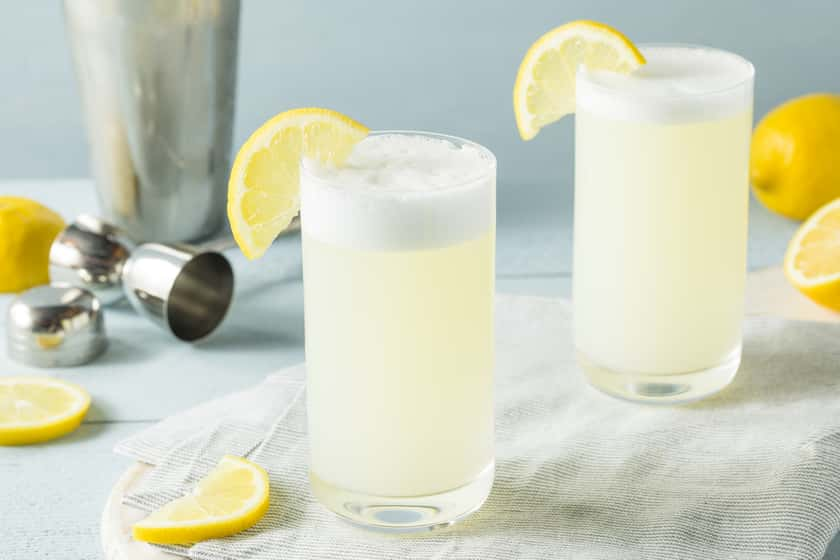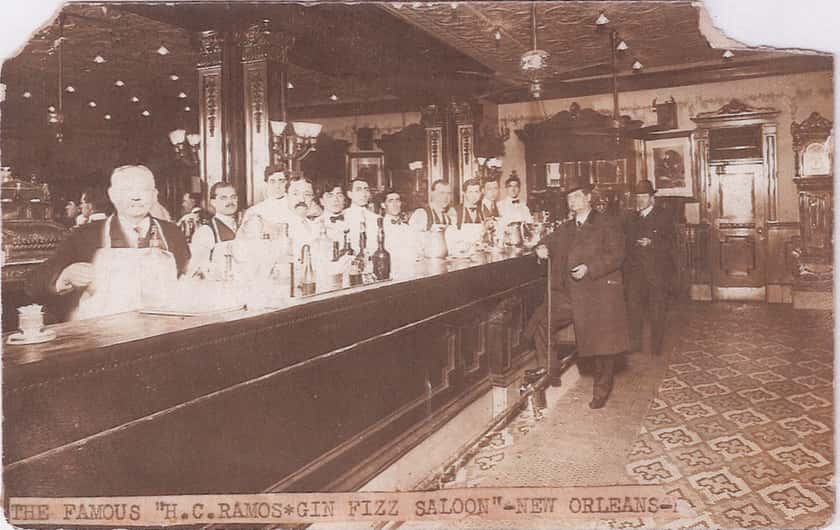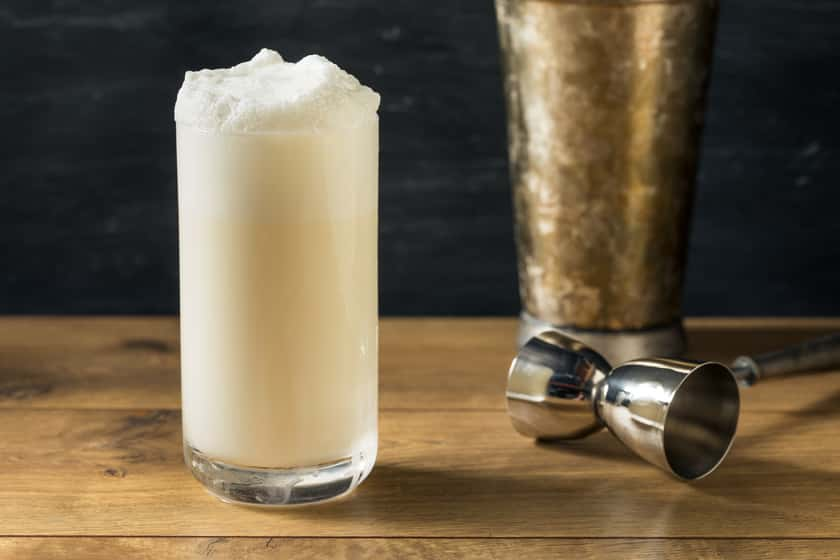How much effort would you put into making your perfect cocktail? Going back to the 19th century, bartenders believed the Gin Fizz should be shaken so long it would induce headaches in the bartender.
That might be an embellishment on the part of some mixologists, but there's no doubt the Gin Fizz, and especially its most popular variant, the Ramos Gin Fizz, can pose a challenge for bartenders.
But trust me, the end result is worth it.
It's a drink that inspired Ernest P. Rawling, writer of Rawling's Book of Mixed Drinks in 1914, to wax poetic. He said:
At any time or in any place where the tongue and throat are dry; when the spirits are jaded and the body is weary; after a long automobile trip on hot dusty roads; it is then that the Gin Fizz comes like a cooling breeze from the sea.

The Gin Fizz is still an oasis to many bar patrons today, especially in New York and New Orleans, where some of the premiere fizzes have been shaken and poured.
(We’ll get to the story behind those cities in a bit)
For many, the long wait time, which maxes out at 30 minutes for a Ramos Gin Fizz, is totally worth it for its flavor and visual appeal. The Ramos is quite literally over-the-top, with fizz levels that rise beyond the rim of the Collins glass with the elegance and grace of an Olympic diver.
And the history is every bit as intriguing as the decadent drink itself, given that there's no shortage of legends surrounding this singular elixir.
Henry Ramos was a preacher and a teetotaler
The Ramos Gin Fizz was a favorite drink of LA senator and Governor Huey P. Long
Gin Fizz was often cited as a hangover cure
One particular drinking competitor drank up to 40 Gin Fizzes in a day
Cocktail scholar David Wondrich has reminded us that sours run the risk of being a little bland: they're simple, straightforward, and made for mass production.
But then the Gin Fizz bubbled onto the scene and proved to be a game-changer in the sour arena.
First described in the first cocktail book–Jerry Thomas' The Bartender's Guide in 1876–the fizz was an effervescent concoction that lived up to the name of elixir
' since it served as a hangover cure.
It was a hair-of-the-dog made refreshing and even vitamin-rich when an egg was added. Sounds to me like a proper breakfast!
The classic recipe wasn't very different from the one we know today, calling for gum syrup, lemon juice, and Old Tom gin with seltzer water added after a brief shake.
But not everyone thought of it as a mere hangover cure. In fact, you can make a good many hangovers with this addictive drink as a Brooklynite called Professor
Denton could attest to.
The professor was a professional drinking champion in the 1890s, and the Gin Fizz was easily a favorite of his.
Denton's claim to fame was consuming a remarkable 40 Gin Fizzes in a day. It was no doubt a sight to behold to see the man knocking back so many.
But as the story goes, it got even more interesting one day when his ego got the better of him and he decided he could eat the glass the Gin Fizz came in. He died of internal hemorrhaging.
(Don't try this at home).
Even though imbibing 40 Gin Fizzes is a bit extreme, it's not hard to see how one might go a little overboard with this creamy fizz. Even in Jerry Thomas's original recipe he says it should be drunk "without hesitation." It wasn't meant to sit for a long time over dinner and be occasionally sipped.
But ironically, it continued pulling double duty as a cure for the hangover blues.
In 1882, Harry Johnson's New and Improved Bartender's Manual described the Morning Glory Fizz, which departs from the original by its use of Scotch whiskey and absinthe instead of gin.
As with the 1883 Silver Fizz from Chicago, this eye-opener included egg white along with lemon juice and sugar.
And if you want a touch of sunlight in your morning cocktail, you can make a Golden Fizz by using the yolk instead of the white.
Looking at its history as a party drink and recovery medicine, it's hard to believe that the most famous variant of the Gin Fizz–the Ramos Gin Fizz–was invented by a teetotaling preacher from New Orleans.
The notoriously challenging Ramos Gin Fizz got its start in 1888 at the hands of Henry C. Ramos, when he began bartending at the Imperial Cabinet Saloon on the corner of Gravier and Carondelet Streets.

At the time, many parts of the South and Midwest were drying up, so people were enjoying the comparatively active bar scene in New Orleans.
Despite promptly closing its doors at 8 pm, Ramos' bar was a hit with drinkers, especially those who wanted a taste of Ramos' Gin Fizz.
Newspapers as far away as Kansas City lauded the Imperial Cabinet for its frothy fizzes. And in 1888, they also highlighted William Schmidt, a bartender in New York who cited the secret to the perfect Gin Fizz as the shaking time. The greatest secret to my Gin Fizz,
Schmidt said, Is that I shake it well.
Even though Schmidt needed a longer shake for his creamy Gin Fizz, the wait time for the Ramos Gin Fizz was especially long–up to 15 minutes!
Some say this was intentional because the preacher wanted folks to sober up between drinks. However, there were aspects of Ramos' recipe that were unique and required extra effort.
The addition of heavy cream with egg white is a combo that's especially tough to emulsify. Although 15 minutes might be a bit extreme, there's no doubt the preparation had to last at least 6 minutes.
But the drink was so popular there was no way Ramos was going to be able to do all that shaking himself. And that's where another interesting legend enters the picture.
Some say Ramos employed a number of shaker boys
--a procession of children whose sole job was to shake his Gin Fizzes. It certainly calls up sad, Charles Dickens-style images of child labor, but it turns out it didn't happen that way.
Still unfortunate is the fact that the "shaker boys" were actually Black men who had to shake a deluge of fizzes to meet the demand from patrons.
Mardi Gras was an especially rough time, with 6 men having to work each shift just to shake.
Strangely enough, Henry Ramos probably didn't learn for himself if all that effort was worth it, as he never touched a drop of alcohol in his life. A law-abiding businessman, Ramos got rid of his liquor when prohibition started, walked away from the bar, and started new ventures in painting with his brother.
But lucky for other bartenders (and patrons) that Ramos didn't jealously guard his recipe. Rather, he gave it away to anyone who wanted it. Eventually, Ramos would sell the rights to the recipe to New Orleans' Roosevelt Hotel.
Unlike Henry Ramos, Huey P. Long wasn't shy about consuming the New Orleans original.
As a controversial senator, Huey P. Long made the paper for a lot of things from early rumors that he shot two men at a brothel to his extreme, socialist politics.
But in 1935 The Times focused on his trip to a New York hotel where he was appalled by the way they butchered his beloved Gin Fizz.
It's because of this trip that The Times credits Huey Long with bringing the Ramos Gin Fizz to New York. When Long downed one, then two, then three Gin Fizzes at the Hotel New Yorker, he claimed each was worse than the last.
In the wake of such an emergency, he called in his pet bartender Sam Guarino–the lead mixologist at the Roosevelt Hotel–to show New Yorkers how it was done.
You might say Sam was the fizz wiz, best in the biz!
Mr. Long reminded everyone he was on the wagon at the time (which is clearly why he downed only three Gin Fizzes), but he decided to drink a proper Ramos with the rest of the bar anyway. He definitely took one for the team!
As a result of the performance, Sam Guarino became a minor celebrity in New York and other places and was even called upon to make personal appearances. Sam's star power likely helped spread the Ramos around, and high-end bars in New York know how to make the elixir thanks to ol' Sam.

For his part, Huey Long would soon be assassinated in the Louisiana State Capitol building. But hey, there’s a bridge in New Orleans named after him…so that’s something!
If you visit the home city of the Ramos Gin Fizz, you'll find some variation from place to place when it comes to how long it takes to shake.
Hop into Peychaud's on Toulouse Street. and you'll be surprised that the shaking is outsourced to a blender. There you can order an amazing Gin Fizz without the guilt that comes with giving your bartender sore arms and a possible migraine.
But most places still do it manually, and the time will often vary between 5 minutes and 10 minutes.
Not so at Bar Tonique on Rampart St. They'll warn you up front that your Ramos Gin Fizz will take up to 25 minutes, and they're not allowed to take shortcuts.
At Tonique, they'll even turn it from a spectator sport to a participatory one if the situation allows. As the bartender pauses to run hot water over her frigid hands, the shaker is in the hands of a patron who consents to take over.
In the end, you get a beautiful cloud of a drink with a floral aroma and a fluffy head that reaches above the glass. An orange peel garnishes the rim for elegant contrast. Needless to say, the drink is gone much faster than it takes to shake.
And there's always the option to make one in your own kitchen.
But if making the Ramos yourself isn't a challenge you're ready for, start with a classic Gin Fizz with 1 ½ oz of your favorite gin, ¾ oz of lemon juice, ¾ oz of simple syrup, and top with soda water.
You'll want to add all the ingredients together and shake them up for 10-15 seconds then top with soda. Add egg white to the mix for a Silver Fizz.
But once you've gotten a taste for it, why not up the ante?
At the next party you throw, you can opt to do things the Ramos way and get ready to shake the drink for 10 minutes–maybe 15 if you're feeling extra strong. And perhaps you can give the rest of the party-goers a role in the action–it will quite literally shake up the evening!
As an added bonus, all that shaking burns off some of the calories you’ll be putting on when you drink your fizz!
Ingredients:
2 oz Tom gin
½ oz Lemon juice
½ oz Lime juice
¾ oz Simple syrup
½ oz Orange flower water
¾ oz Egg white
¾ oz Cream or half and half
Top with soda water
Directions:
Shake all ingredients with ice (except soda) for 6 minutes
Strain back into the shaker
Shake without ice for 4-6 minutes
Slowly pour ⅔ of mix into a chilled Collins glass (no ice)
With free hand, pour soda water into glass simultaneously
Let it settle in freezer for 1 minute
Top with remaining contents of shaker until it fizzes above the rim
Garnish with orange peel